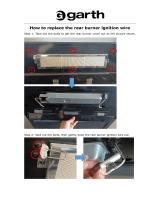
E Installing the Appliance 23
E1 Double Sided conversion 23
E2 Installing the Appliance 24
E3 Connecting the Flue 24
E4 Connecting the Network Cable 24
E5 Removing (and replacing) the Glass 25
E6 Remove the Fuelbed Tray & Burners 25
E7 Gas Type Conversion 26
E8 Checking the Gas Operating Pressure 28
E9 Operating the Appliance 29
E10 Auxillary On/O button 30
E11 Home Automation Setup 30
E12 Reinserting fuel bed and ceramic glass 31
F Finishing the Installation 32
F1 Crystalite, Coal, or Driftwood Fuel Bed Installation 32
F2 Log and cone Fuel Bed (Woodland Selection) 32
F3 Wall lining 33
F4 Fitting the Fascia Panels 34
F5 Locating Wall Mount Cradle for Wireless Control 35
F6 Operating the Appliance 35
F7 Normal Operating Sounds and Smells 37
G Installation Checklist 38
S Service Manual 39
S1 Annual service procedure 39
S2 Error Codes 40
S3 Cleaning the Fuel bed and Glass 42
S4 Checking Operating Pressure 43
S5 Replacing a Remote Control 44
S6 Replacing the burners 45
S7 Accessing the control tray 46
S8 Removing the Circuit Board 46
S9 Servicing the Horizontal / Vertical Powerue 48
S10 Wiring Diagram 49
S11 DX1000 Star Rating Labels 50
S12 DX1500 Star Rating Labels 51
























